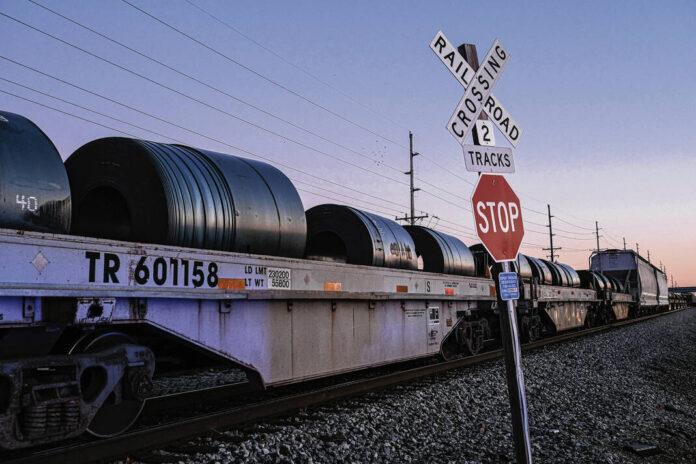
Mike Wolanin | The Republic A view of a train on the Louisville & Indiana tracks alongside Indianapolis Road in Columbus, Ind., Monday, Nov. 21, 2022.
Local first responders say they regularly undergo training on how to coordinate a multi-agency response in the event of a train derailment — including scenarios in which toxic chemicals are spilled.
The issue of rail accidents and how to respond to them has received national attention in recent weeks after dozens of freight train cars derailed in an Ohio town earlier this month, including 10 cars that were carrying hazardous materials, The Associated Press reported.
The derailment, on Feb. 3 in East Palestine, Ohio, prompted evacuations when toxic chemicals were burned after being released from five derailed tanker rail cars carrying vinyl chloride that were in danger of exploding, according to The Associated Press.
The derailment and its aftermath has left residents there questioning the potential health effects even as authorities maintained they were doing their best to protect people.
It also raised questions about rail safety across the country, including in Bartholomew County, where freight trains run northbound and southbound near the city’s drinking water well field south of Columbus.
Currently, it is unclear what types of hazardous materials, if any, are hauled through Bartholomew County by rail.
The Federal Railroad Administration, which enforces rail safety regulations, including the transportation of hazardous materials, declined to disclose what types of hazardous materials have been hauled through Bartholomew County in the past or this year.
The Louisville & Indiana Railroad, which owns the rail line that runs underneath the overpass on the Columbus’ west side also declined to disclose what types of hazardous materials, if any, are shipped through the county, citing security concerns.
However, local officials said they are under the impression “that there isn’t a huge amount of (hazardous) chemicals” transported by rail through the county.
For its part, the Columbus Fire Department undergoes training and participate in exercises and a “large-scale disaster drill” that often involve rail incidents, including “derailment or some sort of chemical release,” said spokesman Capt. Mike Wilson.
“We do actually prepare for railway incidents,” Wilson said. “…We identify all the considerations we need to take care of in terms of public safety, evacuations.”
“There is a lot to it,” Wilson added. “Those are very dynamic types of scenes and require a lot of people.”
Training and exercises
The Louisville & Indiana Railroad offers free training to first responders in Bartholomew County and elsewhere on how to respond to a range of scenarios, including “training that is applicable toward what happened in East Palestine, Ohio,” said railroad President John Goldman.
The training, which generally takes place each year, aims to help first responders get familiar with the train cars and equipment, as well as “setting up command centers, issuing first aid and addressing any other health issues,” Goldman said.
“It helps prepare (first responders) for non-emergency events and to help them assist us with large-scale events such as what happened in Ohio,” Goldman said.
Louisville & Indiana Railroad officials notified the city in 2018 that longer, heavier and faster CSX trains would begin traveling through Columbus on the Louisville & Indiana rail system beginning near the end of that year.
In 2018, Goldman said most of those CSX trains would be carrying automotive items, but predicted more boxcars carrying general merchandise would be added.
Louisville & Indiana Railroad and CSX Transportation won approval in April 2015 from the federal Surface Transportation Board to use L&I’s 106-mile mainline between Louisville and Indianapolis jointly and to upgrade it from jointed steel rails to continuous welded ones to allow high speed rail traffic.
The new rails would allow heavier and faster trains to move through Columbus, Seymour and other cities along the rail line. The plan called for CSX to invest $70 million to $90 million in improvements, and to shift an estimated 13 to 15 trains per day to the L&I line, in addition to the L&I trains.
A 2016 study by Indianapolis engineering firm American Structurepoint Inc., commissioned by the city, indicated as many as 22 trains were traveling through the State Road 46/State Road 11 intersection, and other Columbus downtown rail intersections each day. The new railroad overpass eliminated the State Road 46 railroad crossing, but the remaining downtown crossings and those north and south of the city remain the same, some with lights and crossbars, others without the safety protections.
‘Tabletop drills’
In addition, local first responders also periodically participate in a “large-scale disaster drill specifically around railway incidents,” Wilson said.
The drill, which Wilson described as a “large tabletop type exercise,” generally involves multiple agencies and organizations, including Bartholomew County Emergency Management, Columbus Fire Department, Columbus Police Department, Bartholomew County Sheriff’s Department, Columbus Regional Health, railroad representatives, among others, officials said.
Tabletop exercises are discussion-based sessions where team members meet to discuss their roles during an emergency and their responses to a particular situation.
“It really tests the agencies to come together and work together on that type of an event, which in the real world, that would be a must,” Wilson said. “You’ve got to have seamless coordination between all the agencies involved.”
Bartholomew County Emergency Management Director Shannon Cooke said representatives from the Louisville & Indiana Railroad and some elected officials also often attend the county’s own exercises to go through scenarios.
“We’ve had one (exercise) where we’ve had a (hypothetical) train derailment right downtown,” Cooke said. “…Sometimes we throw a hazardous material (exercise) in there just to give us that training piece of it. How do we respond to it? It’s affecting the roadways, it’s affecting the river, it’s affecting the air quality.”
Currently, the Louisville & Indiana Railroad does not generally provide advance notice to local first responders that hazardous materials will be hauled through the county, officials said.
Instead, local officials said they can quickly contact the railroad to find out exactly what is on board the train in the event of an incident. The Columbus Fire Department also has hazardous materials technicians who can “formulate the best approach for managing the scene,” Wilson said.
While local officials said the on the ongoing training can help keep them “ahead of the curve,” there’s no way for them to know exactly when, where or how a rail incident will occur and to predict specifically what response will be required.
“We do have a lot of train activity through the area, and you never know where the incident could occur or how the incident occurs,” Wilson said. “…Anywhere in the county, one of those incidents could occur.”




